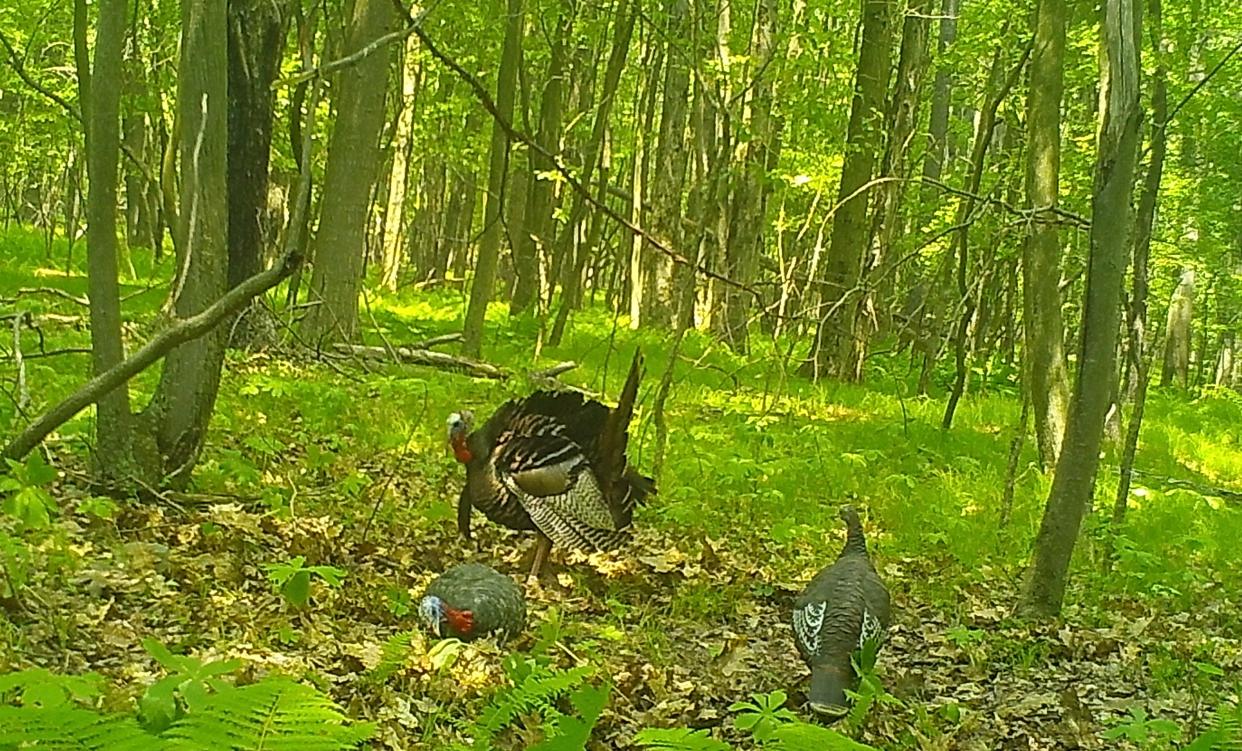Turkey decoy placement, setup: Tips to call in a gobbler this spring
At first glance, one might think that there is really nothing to putting out turkey decoys.
Right?
Just put the plastic replicas in a field, get yourself hid nearby and call.
Birds see the decoys and come right in.
Yeah, right.
I think there is a bit more to it than that.
Some toms are actually shy of decoys. Maybe they have been shot at, had a bad experience, spooked.
They are smart and learn quickly.
And other toms are “lovers not fighters.” If they see a jake decoy, they don’t want to have anything to do with it.
And yet gobblers can be crazy around decoys, too.
Last season I got more than 1,000 photos of a young tom trying to breed a decoy. He would mount the hen decoy and fall off, over and over and over.
Even when the decoy was knocked off its stake and was laying on its side, he still wouldn’t quit.
What made it even more perplexing, a pair of real hens walked past.
But that crazy tom didn’t care, never even looked at them … so infatuated with that plastic decoy.

The two ways to hunt spring gobblers
There are two basic ways to hunt spring gobblers, either in a stationary blind, or moving out amongst them.
A popup blind or a shooting house, an elevated box blind, needs to have the decoys situated so that the hunters inside have a good view, within the shotgun’s wheelhouse. When it comes to distance, it of course depends upon the gun, the shooter, and the loads.
New guns with choke tubes and new TSS loads give hunters extra distance, depending upon a lot of variables, again such as the shooter, the gun, the load, and the hunting situation (across an open field or in the woods).
I hunt mostly the old fashioned way of “running and gunning,” calling birds in different woods, fields and meadow situations. No blinds.
And that is where the setting up of the decoys, their positioning, becomes problematical.
Say you are hunting the edge of a steep hollow, and prospecting with your call and luckily you get one to sound off.
What do you do?
How are you going to set up the decoy/decoys (I usually carry two, a jake (young tom) and a hen?

The three basic ways to set up turkey decoys
There are three basic possible ways to set up turkey decoys.
I’ve killed a lot of birds each way, so there is really no favorite. It all depends on the situation, cover, and aggressiveness of the tom, meaning how responsive he is.
The first position would be to set up the decoys between you and the gobbler.
When the tom sounds off again, move a bit ahead, set up the dekes, quickly and efficiently, and slide back a bit, maybe 30 yards or so, and get hid.
That’s one way, and of course there are pros and cons. One caution, especially early in the season before the leaves come out: Moving ahead risks getting spotted. Gobblers have incredible sight and can easily spot human movement from the bottom of a hollow to the top.
The second way is to walk back, away from the tom, and set up the decoys behind, say, in a field, 30 to 50 yards back. Make some feeding clucks, and then move up to where the tom was first heard and get hid.
Of course there are pros and cons to that way too. Toms will circle and come in from out of range.
More: How turkey behavior, poult survival are affected by an early spring warm-up
The third setup is what I call a flanking move.
This can be lethal, but depends a bit on the cover, the foliage, and the overall setting.
I like to place the decoys down a bit and hidden (maybe behind a tree or stump) on the slope so that if the tom is coming from above (as they often like to circle when coming in, especially later in the season), he’ll spot those decoys and stand on tippy toe, stretching his long neck out to get a better look down at them.
And with the flanking setup, we are off to the side as he comes in.
I’ve tumbled a bunch of toms that way, but then I’ve tagged a bunch by putting the dekes in front, and a bunch by putting the decoys behind, too.
But there’s always room to second-guess, when it comes to turkey hunting … and when the tom won, which he surely will, “If I’d only set up the decoys differently …”
-- Oak Duke writes a weekly column.
This article originally appeared on The Evening Tribune: How to set up turkey decoys to call in a gobbler this spring
